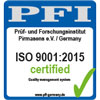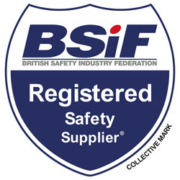STANDARDS OVERVIEW
EN ISO 9001
ELTEN operates an ISO 9001:2015 certified quality management system. This international standard defines requirements based on which we set up, manage and continuously improve our internal processes, such as development, purchasing or production.
EN ISO 14001
ELTEN operates an environmental management system certified according to ISO 14001:2015. This international standard defines requirements based on which we set up, manage and continuously improve our internal processes. This includes, for example, identifying environmental aspects and defining environmental targets to optimise our environmental performance.
EN ISO 17249
EN ISO 17249 specifies requirements for safety footwear with a protection effect against chainsaw cuts as personal protective equipment (PPE). This includes requirements and levels of protection for footwear in the assembled state as well as for individual components (shoe upper, lining, shoe tongue, insole, cover insole, inlay sole and outsole).
| Level of protection | Chain speed in m/s |
| 1 | 20 |
| 2 | 24 |
| 3 | 28 |
EN ISO 20345:2022
STATUS EN 20345
The EN standards DIN EN 20345:2022, DIN EN 20346:2022 and DIN EN 20347:2022 were published in the 2nd quarter of 2022.
The standards for forestry boots, firefighter boots and foundry boots are not yet ready for publication.
Major changes:
The familiar categories still exist:
Class I: SB, S1, S2 and S1P/ S3
Class II: S4 and S5 for plastic boots
There are 2 new categories for class I: S6 and S7.
Accordingly, for occupational footwear, the following apply: OB, O1, O2, O3, O4 and O5 and the 2 new categories O6 and O7.
Changes with regard to the categories:
Fuel resistance is no longer a basic requirement. It will become an additional requirement, as is already the case for work shoes. As a result, all SB, S1, S2, S3, S4, S5, S6 and S7 articles will be marked with the additional FO marking, if desired, if the sole is still fuel-resistant.
S6: Is an S2 article, but must additionally be tested for waterproofness for the entire shoe. This corresponds to the previous “WR” test.
S7: Is an S3 article, but must additionally be tested for waterproofness for the entire shoe. This corresponds to the previous “WR” test.
A shoe marked “S2 WR” is identical to one marked “S6”. The same applies to a shoe marked “S3 WR”, which is identical to one marked “S7”.
Changes in penetration resistance:
A test with a 3.0 mm nail is now also included. The previous requirement with a 4.5mm nail remains. In future, however, shoes must be labelled according to their built-in penetration protection material, while “S3” will only be used for shoes with steel soles, and no longer for those with textile penetration protection.
From now on, the following footwear labelling will be available for footwear with penetration protection:
S3 or S1P = shoe with steel sole
S3L or S1PL = shoe with textile penetration protection (as before with 4.5 mm nail)
S3S or S1PS = shoe with textile penetration protection material (NEW with 3.0 mm nail)
S7 or S3 WR = shoe with steel sole that also fulfils the WR test
S7L or S3L WR = shoe with textile penetration protection (4.5 mm nail) that also meets the WR test
S7S or S3S WR = shoe with textile penetration protection material (3.0 mm nail), which also fulfils the WR test.
Slip resistance:
Shoes will no longer be marked as SRA; SRB or SRC.
Slip resistance becomes a basic requirement and is no longer marked. It is possible to have an additional combination of tile and glycerine tested, but it is not mandatory.
The new additional requirements:
SC = The overcap has some degree of abrasion.
SR = The voluntary additional test for slip resistance tile/glycerine is fulfilled
LG = the shoe has a specific heel shape (for use with ladders)
EN ISO 20349-1: STANDARD FOR FOUNDRY BOOTS
FOOTWEAR FOR PROTECTION AGAINST RISKS IN FOUNDRIES
This standard for footwear for protection against risks in foundries supplements EN ISO 20345 for safety footwear to meet minimum requirements in foundries. Foundry boots are tested for various criteria, with particular emphasis on flame resistance and resistance to molten metal. Depending on the result, the shoe is labelled with “Al” after successfully passing the test with liquid aluminium and/or “Fe” after successfully passing the test with liquid iron. All the labelling introduced in EN ISO 20345 remains unchanged.
Basic test: The pouring test
- the pouring test is carried out with molten metal, during this test a temperature of approx. 1,400°C (= steel) or approx. 780°C (= aluminium) is reached
- no molten metal may penetrate the upper material of the shoe for a period of 10 seconds
- the flames produced during the casting test must be extinguished within 5 sec
Additional test requirements:
- the upper leather must pass a contact heat test (6 sec at 500°C) without damaging the inner lining
- slip resistance according to SRA, SRB or SRC
- the outsoles meet the requirements of EN ISO 20345 HI
- both boots must be easily removable within 5 sec
Requirements for the shaft construction:
- minimum height of the upper form C
- no metal shall be allowed to adhere to the outer surface
- all seams must be made of flame retardant yarn and have an overlap
- the upper rim of the boot must be designed to allow the wearer a firm fit of the boot
EN ISO 20349-2: STANDARD FOR WELDING BOOTS
FOOTWEAR FOR PROTECTION AGAINST RISKS DURING WELDING AND RELATED PROCESSES
While the standard EN ISO 20345 specifies the general basic requirements for safety footwear, EN ISO 20349-2 specifically addresses the special conditions for welding and related processes. The focus is on protection against flames and molten metal splashes that can occur during this type of work. Footwear that has been tested to provide effective resistance to splashes of molten metal is labelled ‘WG’. All other markings from EN ISO 20345 remain unchanged.
Additional test requirements:
- the shoes are tested for resistance to splashes of molten metal (WG marking)
- flames produced during the test must not continue to burn or glow for longer than 2 seconds
- slip resistance according to SRA, SRB or SRC
Requirements for the shaft construction:
- minimum height of the upper form B
- there must be no upward-facing seams (open edges) in the front 2/3 area of the shoe
DIN EN 15090
For firefighting boots
| TYP 2 | Qualified for all firefighting and rescuing missions, where penetration resistance and toe protection is needed. No protection against chemical substances. |
| F2A | Firefighter boot type 2 with toe protection, penetration resistance and antistatic properties. |
| HI3 | Heat isolation at 250 C (40 min. exposure time) |
ADDITIONAL REQUIREMENT
It is important that safety shoes be chosen for the established protection requirements and the corresponding area of use. A suitable shoe must be chosen on the basis of a hazard analysis. You can also receive detailed information about this at the corresponding mutual indemnity associations.
P Penetration resistance
A Antistatic shoe
HI HI Heat insulation (up to max. 150°C for 30 mins)
CI Cold insulation (up to max. -17°C for 30 mins)
E Heel energy absorption
WPA Water penetration resistant uppers
HRO Heat-resistant outsole (up to max. 150°C for 1 mins)
M Metatarsal protection
CR Cut resistance (not against chainsaw cuts)
AN Ankle protection
FO Fuel resistance
LG Ladder grip
SC Scuff cap
SR Skid resistance
CE
The British Safety Industry Federation is the key independent voice representing the interests of the UK safety industry to a wide audience, including Government, its enforcement agencies, standards making authorities and safety equipment users. ELTEN is a member of the British Safety Industry Federation.
This company undertakes to supply only safety equipment and/or related services that fully comply with the standards and regulations and claims made relating to those products and/or related services. Where appropriate, this company will maintain up to date technical files and associated documentation to ensure that regulatory compliance information can be supplied upon request.
PSA Regulation 2016/425
ELTEN GmbH has carried out the conformity procedure for its safety shoes in accordance with the PPE Regulation 2016/425 and maintains the associated technical documentation, type examination certificates and declarations of conformity in accordance with the procedure of the PPE Regulation 2016/425. The associated products are marked with the CE marking. The respective declaration of conformity can be found on the detailed pages of our safety shoes. Or on this subpage.




